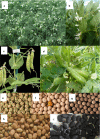Improving pulse crops as a source of protein, starch and micronutrients
- PMID: 31598097
- PMCID: PMC6772023
- DOI: 10.1111/nbu.12399
Improving pulse crops as a source of protein, starch and micronutrients
Abstract
Pulse crops have been known for a long time to have beneficial nutritional profiles for human diets but have been neglected in terms of cultivation, consumption and scientific research in many parts of the world. Broad dietary shifts will be required if anthropogenic climate change is to be mitigated in the future, and pulse crops should be an important component of this change by providing an environmentally sustainable source of protein, resistant starch and micronutrients. Further enhancement of the nutritional composition of pulse crops could benefit human health, helping to alleviate micronutrient deficiencies and reduce risk of chronic diseases such as type 2 diabetes. This paper reviews current knowledge regarding the nutritional content of pea (Pisum sativum L.) and faba bean (Vicia faba L.), two major UK pulse crops, and discusses the potential for their genetic improvement.
Keywords: biofortification; essential amino acids; favism; legume; resistant starch; sustainability.
© 2019 The Authors. Nutrition Bulletin published by John Wiley & Sons Ltd on behalf of British Nutrition Foundation.
Conflict of interest statement
No conflicts of interest have been declared.
Figures

Similar articles
-
Checking Agriculture's Pulse: Field Pea (Pisum Sativum L.), Sustainability, and Phosphorus Use Efficiency.Front Plant Sci. 2019 Nov 15;10:1489. doi: 10.3389/fpls.2019.01489. eCollection 2019. Front Plant Sci. 2019. PMID: 31803218 Free PMC article. Review.
-
Perspectives on the genetic improvement of health- and nutrition-related traits in pea.Plant Physiol Biochem. 2021 Jan;158:353-362. doi: 10.1016/j.plaphy.2020.11.020. Epub 2020 Nov 17. Plant Physiol Biochem. 2021. PMID: 33250319 Free PMC article. Review.
-
First Report of Chickpea chlorotic stunt virus Infecting Legume Crops in Tunisia.Plant Dis. 2011 Oct;95(10):1321. doi: 10.1094/PDIS-10-10-0708. Plant Dis. 2011. PMID: 30731675
-
Nordic Crops as Alternatives to Soy-An Overview of Nutritional, Sensory, and Functional Properties.Foods. 2023 Jul 5;12(13):2607. doi: 10.3390/foods12132607. Foods. 2023. PMID: 37444345 Free PMC article. Review.
-
Faba Bean Cultivation - Revealing Novel Managing Practices for More Sustainable and Competitive European Cropping Systems.Front Plant Sci. 2018 Aug 2;9:1115. doi: 10.3389/fpls.2018.01115. eCollection 2018. Front Plant Sci. 2018. PMID: 30116251 Free PMC article. Review.
Cited by
-
Effects of High Doses of Selenate, Selenite and Nano-Selenium on Biometrical Characteristics, Yield and Biofortification Levels of Vicia faba L. Cultivars.Plants (Basel). 2023 Aug 1;12(15):2847. doi: 10.3390/plants12152847. Plants (Basel). 2023. PMID: 37571001 Free PMC article.
-
Regulation of the Zinc Deficiency Response in the Legume Model Medicago truncatula.Front Plant Sci. 2022 Jun 30;13:916168. doi: 10.3389/fpls.2022.916168. eCollection 2022. Front Plant Sci. 2022. PMID: 35845702 Free PMC article.
-
Association study of crude seed protein and fat concentration in a USDA pea diversity panel.Plant Genome. 2025 Mar;18(1):e20485. doi: 10.1002/tpg2.20485. Epub 2024 Jul 31. Plant Genome. 2025. PMID: 39086082 Free PMC article.
-
Strategies and bibliometric analysis of legumes biofortification to address malnutrition.Planta. 2024 Sep 4;260(4):85. doi: 10.1007/s00425-024-04504-0. Planta. 2024. PMID: 39227398 Review.
-
A Study on Legume-Based Noodles as Staple Food for Office Workers.Front Nutr. 2022 Mar 11;9:807350. doi: 10.3389/fnut.2022.807350. eCollection 2022. Front Nutr. 2022. PMID: 35360683 Free PMC article.
References
-
- Amarakoon D, Thavarajah D, McPhee K et al (2012) Iron‐, zinc‐, and magnesium‐rich field peas (Pisum sativum L.) with naturally low phytic acid: a potential food‐based solution to global micronutrient malnutrition. Journal of Food Composition and Analysis 27: 8–13.
-
- Amarakoon D, Thavarajah D, Gupta D et al (2015) Genetic and environmental variation of seed iron and food matrix factors of North‐Dakota‐grown field peas (Pisum sativum L.). Journal of Food Composition and Analysis 37: 67–74.
-
- Ambigaipalan P, Hoover R, Donner E et al (2011) Structure of faba bean, black bean and pinto bean starches at different levels of granule organization and their physicochemical properties. Food Research International 44: 2962–74.
-
- Baloch FS, Karaköy T, Demirbaş A et al (2014) Variation of some seed mineral contents in open pollinated faba bean (Vicia faba L.) landraces from Turkey. Turkish Journal of Agriculture and Forestry 38: 591–602.
-
- Barać MB, Pešić MB, Stanojević SP et al (2015) Techno‐functional properties of pea (Pisum sativum) protein isolates‐a review. Acta Periodica Technologica 46: 1–18.
Publication types
LinkOut - more resources
Full Text Sources

